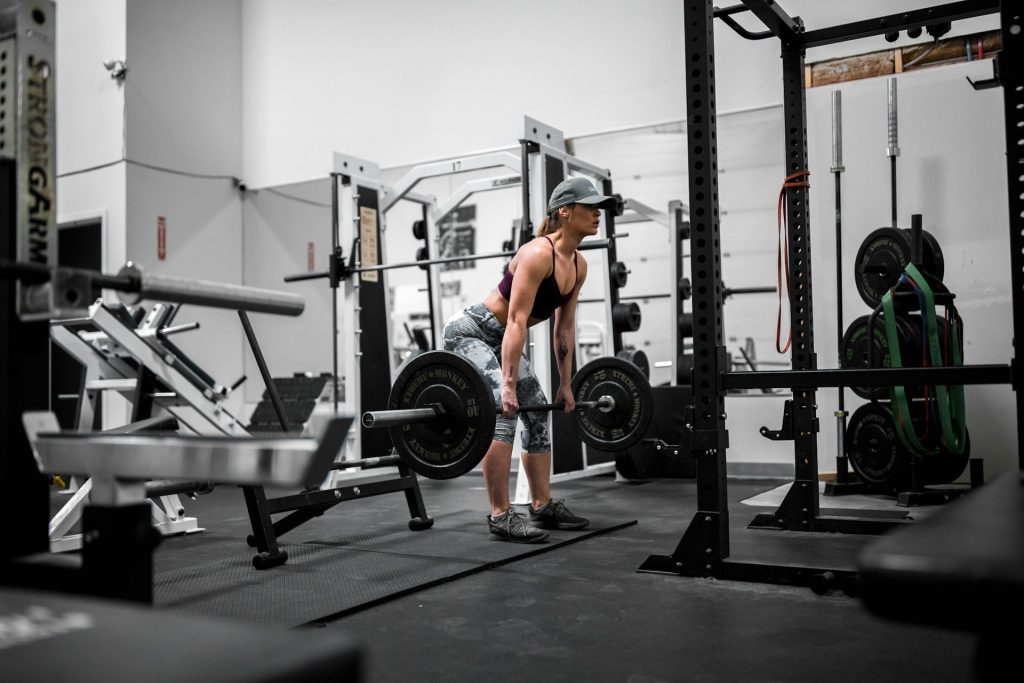If you’re aiming to ramp up your fitness game, the question “How often should you deadlift?” probably goes through your mind. Deadlifting transcends beyond merely bulking up your muscles, it’s about improving your overall physical power. But why is this so important? Let’s find out.
Table of contents
MORE keyboard_double_arrow_down LESS keyboard_double_arrow_up
What Exactly Is A Deadlift?
The deadlift is a compound exercise that targets major muscle groups, such as the back, legs, core, and glutes. It’s highly regarded for enhancing both strength and muscle mass, serving as a functional movement mimicking the everyday action of bending down to pick up items.
This mirrors activities like handling the garbage, doing laundry, lifting a child, or picking up objects around the house, tasks performed frequently throughout the day.
Given its engagement of significant muscle groups, the deadlift not only boosts strength but also elevates heart rate, burns calories, and enhances balance and coordination. Many individuals, especially those pursuing athletic improvements, train the deadlift multiple times a week due to its numerous benefits and its inclusion as a fundamental exercise for weightlifters.
Furthermore, Taylor Atwood a powerlifting world champion also states how beneficial deadlifting is:
However, it’s crucial to note that while frequent deadlift training is common, doing a heavy deadlift workout every day is strongly discouraged due to its taxing nature. The question then arises: how often should you deadlift?
How Often Should You Deadlift?
Before delving into the discussion on how often you should deadlift, it’s essential to address the general training frequencies for each muscle group. Online, you may come across experts suggesting specific numbers like deadlifting three times a week, squatting twice, and running five times for an ideal physique.
However, this is a generic template that overlooks various crucial factors, such as:
- Your weekly training availability
- Your level of training experience
- Other types of exercises in your routine
- Your personal preferences
- Your specific training goals
- The volume of training you can handle
How Many Times Should You Train Per Week?

If you’re not a professional athlete, it’s improbable that you can train twice a day or every day. Most likely, you have a limited number of hours each week to invest in improving your fitness. This consideration is crucial when crafting your workout plan and pondering the question, “How often should you deadlift?”
The journey to enhance your deadlift doesn’t just lie in adding more weight to the bar. It’s about smart adjustments to how often you train, how you train, and the role of deadlift accessories in your routine. So let’s see how you can do this.
Your Experience in Training
Distinguish between beginner lifters, advanced athletes, and professionals. Your level is crucial in deciding how often and with what intensity you should deadlift. Beginners might do well with once a week, while advanced lifters could integrate deadlifts more frequently.
Other Types Of Training
Consider your overall training routine. If you’re involved in activities like marathon preparation or frequent soccer games, deadlifting more than once or twice a week might be impractical and could overload your legs.
Your Preferences
If you’re not a powerlifter, fitness enthusiast, or Olympic weightlifter, deadlifting might not be your primary focus. It can still be a valuable addition to your plan, but daily training may not be necessary.
Training Goals
Tailor the frequency of deadlift sessions to your goals. For instance, if you’re training for a tennis tournament, deadlifting multiple times a week may not be necessary. On the other hand, if strength gain is your aim, consider increasing deadlift frequency.
Volume Consideration
Volume, measured by total reps multiplied by the load lifted, plays a crucial role in fatigue. Understanding your volume is essential for proper recovery.
While more training often leads to more strength, research suggests that gains are not limited to specific frequencies. Anywhere between once to three times a week can work, and consolidating the same volume into fewer sessions won’t hinder strength gains.
Should You Increase Deadlift Frequency or Not?

In the journey to amplify strength and muscle, the mantra often becomes “more is better.” However, when it comes to deadlifting, this approach can sometimes lead us astray. Let’s delve into the crucial reasons why increasing your deadlift frequency might not always be the best strategy.
1. The Injury Factor
First and foremost, your health is paramount. Here’s why caution is key:
If you’ve recently been sidelined by an injury, the road back isn’t through excessive deadlifting. Overloading a recovering body part can set you back further instead of propelling you forward.
Even if you’re injury-free, remember that prevention is better than cure. Proper form, balanced recovery times, and listening to your body’s signals are non-negotiable aspects of a sustainable training regimen.
2. Avoiding Burnout
The pursuit of strength can become all-consuming, leading to another potential pitfall: burnout.
Your muscles need time to repair and grow stronger. Deadlifting too often, especially at high intensities, can lead to overtraining symptoms, diminishing returns, and increased injury risk.
Burnout isn’t just physical. The mental strain of constant, intense training can sap your motivation and joy for lifting, making it harder to stick to your goals in the long run.
3. The Deload Principle
After pushing your limits, sometimes what your body needs most is a breather. Implementing deload weeks or reducing the intensity of your deadlift sessions allows your body to recover more effectively, ensuring you don’t hit a plateau or regress in your progress.
This period isn’t about making gains but maintaining them. It’s a time to focus on form, engage in active recovery, and perhaps explore lighter deadlift accessories that support your overall lifting mechanics without overburdening your body.
4. Scheduling Smarts
Integrating deadlifts into your workout schedule is more art than science, requiring a tailored approach. Your optimal deadlift days depend on a variety of factors, including your overall training volume, recovery capacity, and personal goals. There’s no universal “best day” to deadlift, but there is a best day for you.
On days you’re not deadlifting, consider incorporating deadlift accessories that can help maintain your strength and form without the same level of stress on your body. This balanced approach ensures you’re always moving forward, even on lighter days.
Increasing your deadlift frequency can offer benefits, but it’s not a one-size-fits-all solution. Recognizing the signs when to pull back and how to strategically incorporate rest, recovery, and deadlift accessories into your routine is crucial. It’s about finding the right balance that allows for growth without pushing your body into the danger zone.
What Do Experts Say?
Brad Schoenfeld is a renowned fitness expert with a doctoral degree in exercise science and multiple certifications, including Certified Strength and Conditioning Specialist (CSCS). According to Schoenfeld, the frequency of deadlifts should be tailored to individual goals and recovery abilities.
For beginners or those focusing on strength development, performing deadlifts once or twice a week with adequate rest between sessions is recommended. More advanced lifters may benefit from higher frequencies but should be cautious not to overtrain.
Bret Contreras, also known as “The Glute Guy,” holds a Ph.D. in Sports Science and is a leading authority in strength training and biomechanics. Contreras suggests that deadlift frequency can vary based on the specific variation of the exercise being performed.
While conventional deadlifts may require more recovery time due to their taxing nature on the central nervous system and musculature, variations like Romanian deadlifts or trap bar deadlifts could be incorporated more frequently throughout the week.
Tips and Advice
Now that we’ve covered the answer to “how often should you deadlift”, here are some tips to keep in mind when you do this type of workout:
- Start at a pace that feels challenging yet manageable. If you’re new to deadlifting, once a week may be sufficient. More experienced lifters might aim for two or three sessions.
- Pay close attention to how your body reacts. Muscle soreness, fatigue, and progress plateaus are signs that it’s time to reassess your frequency. Maybe it’s time to dial it up or perhaps scale back a bit.
- Deadlift accessory exercises like Romanian deadlifts, hip thrusts, and back extensions can target specific weaknesses, ensuring a well-rounded development.
- Exercises focusing on core stability and grip strength not only enhance your deadlift performance but also reduce the risk of injury.
Conclusion
Embarking on a deadlifting journey presents an opportunity to significantly enhance your strength, form, and overall fitness.
However, the path to mastering this powerful exercise is not solely about how much weight you can pull. It involves understanding the interplay between frequency, technique, and the strategic use of accessories. Let’s dive into practical advice that bridges theory with action.
Armed with these insights, you’re well on your way to unlocking the full potential of your deadlifts, paving the path to achieving and surpassing your fitness goals.
Key Points
- Tailor deadlift sessions to match individual experience and goals is essential, with a general recommendation of 1-3 times per week based on personal recovery and training intensity.
- Utilize deadlift accessories such as resistance bands and weight plates can enhance technique, support muscle strength, and prevent injuries, making them integral to a balanced training routine.
- Adjust deadlift frequency and intensity based on physical feedback and recovery rates is crucial to avoid overtraining and promote sustainable progress.
- Adequate rest between sessions, typically 3-4 days, is vital for muscle recovery and to prevent burnout, ensuring longevity in strength training.
- Align deadlifts with pull days in movement-based training splits maintains structured and effective workout routines.
- Balance deadlift frequency with adequate recovery time, especially for those also engaging in heavy squatting, optimizes strength gains and minimizes injury risk.
- Set realistic deadlifting goals based on lifting experience—from beginner to elite levels—helps in achieving progressive and measurable strength improvements.
FAQs
How Long Should You Wait Between Deadlift Days?
The ideal gap between heavy deadlift sessions is influenced by your muscle recovery speed and soreness level. Generally, performing deadlifts twice a week is optimal for most people, allowing a rest period of 3 to 4 days between sessions. However, this can vary based on individual recovery times and intensity of the workouts.
Should I Deadlift Every Pull Day?
Yes, if your training program is divided into movement patterns, such as push days and pull days, deadlifts should be included on pull days. Being a predominantly pulling exercise, deadlifts fit naturally into this category, ensuring your training remains structured and balanced.
Why Should You Only Deadlift Once a Week?
Deadlifting once a week is often sufficient due to the intensive nature of the exercise and its demand on the body’s recovery systems. For those who are also squatting heavily, spacing out deadlifts and squats can aid in ensuring full recovery.
Some powerlifters even extend this to deadlifting once every two weeks, particularly when focusing on maximizing recovery and performance.
How Heavy Should I Deadlift?
The amount you should deadlift depends on your lifting experience and body weight. A general guideline is as follows:
- Beginner: 45-60% of body weight
- Intermediate: 65-85% of body weight
- Advanced: 90-120% of body weight
- Elite: 125-165% of body weight
These percentages serve as benchmarks to gauge your progress and set realistic goals based on your fitness level.

ABOUT THE AUTHOR
Follow Valen Steven for a dose of fitness enthusiasm, evidence-based advice, and a roadmap to achieving your health and wellness goals.
Subscribe to our Newsletter
Dive into a world of fitness and wellness with our exclusive newsletter! Sign up now and receive weekly power-packs of fitness wisdom




